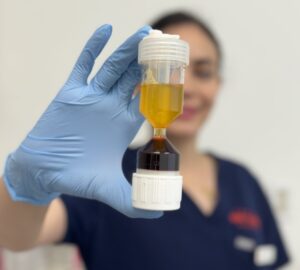It would be great if we could say that the hair loss industry has advanced to the point that it has eliminated all the scam products and service providers out there. But the truth is, you still need to be discerning when it comes to hair loss products since they often prey on the insecurities of people who are just looking for something that works. The same goes for non-medically trained professionals who claim they can perform surgery to save you a few dollars.
ALWAYS KNOW YOUR SURGEON AND YOUR PRODUCT
When it comes to hair loss, there are countless scam products out there that promise the world but ultimately fail to deliver. These types of products are usually aimed at people who are newly suffering from hair loss and are frantically looking for a product that will halt it. The purpose of this guide is to help you avoid falling victim to these products so you can tackle your hair loss effectively.
Types of Hair Loss
Hair loss can be categorized into various types, but two of the most common are female and male pattern hair loss. Male pattern hair loss, or androgenetic alopecia, manifests as a gradual recession of the hairline and thinning of hair at the crown of the head. It typically begins in the late 20s or early 30s and is primarily caused by a combination of genetic and hormonal factors.
Female pattern hair loss manifests differently. Women with this condition experience a gradual thinning of the hair, primarily on the top and crown of the scalp. In contrast to male pattern hair loss, female pattern hair loss usually doesn’t lead to total baldness. Hormonal imbalances, genetics, and aging are some of the factors contributing to this condition.
The Cause of Male Pattern Balding

To avoid hair loss scams, it’s incredibly beneficial to be educated when it comes to the causes of hair loss. The main cause of male pattern balding is due to an increase in dihydrotestosterone (DHT) in the body. DHT causes your hair follicles to shrink and eventually die, which results in thinning hair and, eventually, baldness. There are other things that can contribute to and cause short-term hair loss, including diet, stress and trauma. However, DHT is the culprit in most cases when it comes to male pattern balding. The increase of DHT and the thinning of the hair that occurs, as a result, affects men in different ways and at different ages. Some men will begin to lose their hair as early as their teens, while some guys are lucky enough to still have a full head of hair into their 50s and above. However, the likelihood of hair loss increases significantly after the age of 30.
Causes of Female Pattern Hair Loss
Female pattern hair loss, similar to male pattern hair loss, can also be influenced by genetics and hormonal imbalances. Hormonal changes during menopause, pregnancy, or after discontinuing birth control pills can trigger hair loss in women. Furthermore, specific medical conditions like polycystic ovary syndrome (PCOS) and thyroid disorders can also play a role in female pattern hair loss.
How to spot hair loss scams
One of the big telltale signs of a scam hair loss product is the use of exaggerated language. You should always be wary of any products that are sold using phrases such as ‘undiscovered secret’ or ‘the solution they don’t want you to know about.’ Genuinely effective hair loss products are not sold using such language.
Common Hair Loss Scams to Avoid
Hair loss scams come in various forms, and it can be challenging to distinguish legitimate solutions from fraudulent ones. Some common scams to watch out for include unproven supplements, expensive hair restoration products with dubious claims, and unlicensed clinics offering quick-fix treatments. It is important to remember that hair loss is a complex issue that requires proper medical evaluation and treatment by qualified professionals.
By educating oneself about hair loss treatments, consulting reputable healthcare professionals, and seeking evidence-based solutions, individuals can avoid falling prey to scams and make informed decisions about their hair loss journey.
Hair Transplant Surgeons and Their Role in Treating Hair Loss
Hair transplant surgeons play an important role in treating hair loss and helping individuals regain their confidence. These experts possess extensive training in surgical methods that entail moving hair follicles from another area of the head or another body part to areas experiencing thinning or baldness. Their expertise and experience ensure a safe and effective procedure.
Hair transplant surgeons assess each patient’s unique situation and recommend the most suitable approach, such as the follicular unit excision (FUE) or strip hair transplant (FUT) procedure, to achieve the desired results. They also provide guidance throughout the pre and post-operative phases, ensuring a smooth and successful hair restoration journey.
FAQs
How long does it take to see results after a hair transplant?
Usually, it takes several months for the transplanted hair to begin growing, with full results becoming apparent within 9 to 12 months following the procedure.
Are there any side effects or risks associated with hair transplants?
Like any surgical procedure, hair transplants carry some risks, including infection, bleeding, and scarring. However, these risks are minimal when performed by a qualified and experienced surgeon.
Can women undergo hair transplant procedures?
Yes, women can also benefit from hair transplant procedures. Female pattern hair loss can be effectively treated through hair transplantation.
Are there any non-surgical options for treating hair loss?
Yes, there are non-surgical options available, such as topical medications and laser therapy. However, these options may not be as effective as hair transplant procedures for significant hair loss.
How much does a hair transplant procedure cost?
The expense of a hair transplant surgery can fluctuate based on factors like the severity of hair loss and the number of grafts needed. Consulting a hair transplant surgeon is advisable to obtain an accurate cost estimate.
Conclusion
Understanding the causes of hair loss is vital in finding effective treatment options. Female and male pattern hair loss have different underlying causes but can both be influenced by genetics and hormonal factors. The hair loss industry is riddled with scams, and individuals should be cautious when choosing treatments. Hair transplant surgeons play a vital role in treating hair loss, and both the follicular unit excision (FUE) and strip hair transplant FUT procedure are common techniques used to restore hair growth. By understanding the reasons behind hair loss and avoiding scams, individuals can take control of their hair health and explore suitable treatment options.
If you’re facing hair loss, it’s wise to seek advice from a trusted hair transplant surgeon to explore the most fitting treatment options tailored to your individual situation. Don’t fall for hair loss scams; invest in proven and effective solutions. Your hair deserves the best care.










